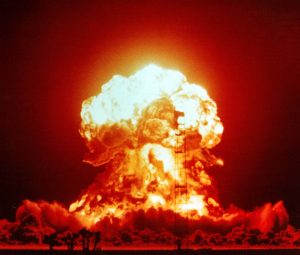With months left before the Trump administration puts out its first Nuclear Posture Review in early 2018, the nonpartisan U.S. Congressional Budget Office (CBO) has released a new report [PDF] on the costs of operating, sustaining, and modernizing U.S. nuclear forces over the next 30 years.
The topline takeaways are familiar: over 30 years, modernization of the air-, sea-, and land-based legs of the nuclear triad, in addition to associated improvements, maintenance, and operation costs, would bring total costs of U.S. nuclear forces to around $1.2 trillion. On a per-year basis, that’s about $41.4 billion.
Those numbers are large, but they’re not new — even independent assessments had pegged the 30-year price tag for U.S. nuclear forces in that range. The CBO had projected a 10-year cost estimate of $400 billion between 2017 and 2026 earlier this year. With all three legs of the U.S. nuclear triad nearly simultaneously looking at replacements for current-generation systems, expected modernization costs have ballooned.
Most interestingly, this newest CBO report outlines nine different force structure scenarios, including one scenario that would delay modernization while maintaining the nuclear force structure, five scenarios that would reduce delivery systems and keep warheads at their New START-proscribed limits of 1,550, and three scenarios that would shape the force around 1,000 warheads — well below the New START limit. The CBO report also presents cost estimates for different dyad configurations (i.e., a U.S. nuclear force that would retain just two among the air-, sea-, and ground-based legs).
The Trump Nuclear Posture Review is widely expected to keep most of the Obama administration’s modernization plans on track and potentially add a few of its own. According to a recent report in the Guardian looking at possible new additions in the Trump NPR, the administration may call for a return of the nuclear Tomahawk land-attack cruise missile (TLAM-N), which was retired in 2013. The administration may also call for a new low-yield warhead for ballistic missile use. (The United States already has warheads and gravity bombs with yields as low as 5 kilotons and 0.3 kilotons respectively.)
Inherent in the CBO’s latest report is the idea of opportunity costs. While U.S. nuclear forces account for less than 10 percent annually of total defense spending, moving ahead with a total modernization of all legs of the triad will carry costs elsewhere. Meanwhile, even within nuclear forces, the dyad and modified triad force structure options presented showcase opportunities for significant cost-saving measures. For instance, eliminating the successor ICBM to the Minuteman III, the Ground-Based Strategic Deterrent (GBSD) project, would save more than $100 billion.

































